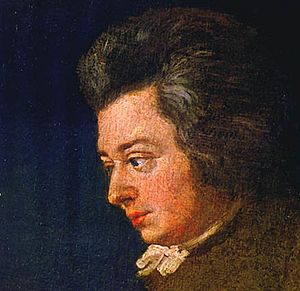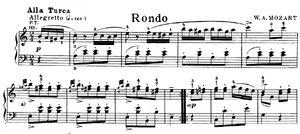Piano Sonata No. 11 (Mozart) facts for kids
The Piano Sonata No. 11 in A major, K. 331, is a famous piece of music written for the piano. It was created by the amazing composer Wolfgang Amadeus Mozart. This sonata was first published in Vienna, Austria, in 1784.
This piece is part of a group of three piano sonatas. Mozart likely wrote them in Salzburg during the summer of 1783. This was when he brought his wife, Constance Weber, to his hometown to meet his father. The other sonatas in this group are No. 10 in C major and No. 12 in F major. Mozart often taught music during his early years in Vienna, so he probably wrote these sonatas for his students to play.
Contents
What Makes This Sonata Special?
This A major sonata is quite unique among all of Mozart's piano sonatas. It doesn't have a movement in what musicians call "sonata form". Instead, it has a different and interesting structure.
First Movement: Theme and Variations
The first part of the sonata is a gentle and flowing tune. It's written in a 6/8 time signature, which gives it a swinging feel. After this main tune, there are six different versions of it. These are called "variations." Some variations are in A major, and some are in A minor, which gives them a slightly different mood. The very last variation changes to 4/4 time, making it feel a bit more steady.
Second Movement: A Graceful Dance
The second part of the sonata is a Menuetto. A minuet is a type of elegant dance. This movement is in A major and has a contrasting section called a "Trio." The Trio is in D major, which adds a nice change of sound. This movement is written in 3/4 time, like a waltz.
Third Movement: The Famous "Alla Turca"
The third and final part of the sonata is very well-known. It's called "Alla Turca," which means "Turkish style." This movement is in 2/4 time and is often called the "Turkish Rondo." It's considered one of the best examples of "Viennese Turkish music" from the late 1700s.
The music in this rondo uses strong, rolling chords in the bass. These chords sound a bit like the drum rolls you might hear from a Turkish Janissary band. Like many classical pieces, this rondo moves between major and minor keys. It also changes between loud and soft sounds, which makes it very exciting to listen to. Many people who play the piano for fun love to perform this piece.
See also
 In Spanish: Sonata para piano n.º 11 (Mozart) para niños
In Spanish: Sonata para piano n.º 11 (Mozart) para niños



